Searching for ideas on how to use more renewable energy in your daily life? Here’s a comprehensive list of 17 ways solar energy can be used at home or in business; including the most common solar powered products to help you live more sustainably.
One thing to note is that solar technology is not a new thing. Actually, harnessing solar energy has been around for centuries now. The first recorded evidence of solar energy usage is dating back to 700 B.C. Back then, people would focus sunlight using magnifying glasses to make fires bigger [1].
Why Use Solar Energy?
Today, solar energy is not a green dream anymore. Rather it’s a technology with a broad application area. From powering our homes and cars with electricity generated from the sun to use it to power consumer electronics and devices using solar energy has many advantages including:
- Helping to slow climate change and reducing pollution. Using solar energy is good for the environment because it does not involve the burning of fossil fuels to create electricity. Therefore it reduces greenhouse gas emissions, noise pollution, and pollutants that are harmful to our health.
- Save money by lowering your energy bills. Reducing the need to draw power from the energy grid and instead of using the power generated for free by the sun can lead to savings of hundreds or thousands each year in electricity and gas bills.
- A way to use less water. Solar power does not pollute the water, and it also does not use as much water, compared to the traditional way electricity is produced.
- Solar energy technologies are a good investment. The global Solar energy industry has been growing rapidly in recent years creating jobs and supporting local businesses.
Currently, Europe dominates the market due to government policies. The industry is estimated to continue growing for the next decade and be a market worth over USD $220 billion by 2026 [2]. - An opportunity to receive discounts, credits, and/or rebates. While the initial cost of installing solar may be high, over the medium to long term it gives a positive return. Today many states or areas offer tax credits, grants, or rebates that may be available to you to offset the upfront costs.
There is also a large Solar Power market where you can also ‘make’ money by feeding the extra solar energy you don’t need or use back into the grid. In return, the power company or utility company will ‘buy’ this energy by crediting your bill/account. This is known as net metering.
What Can Solar Energy Be Used For?
#1 Solar Energy to Generate Electricity To Power Your Home
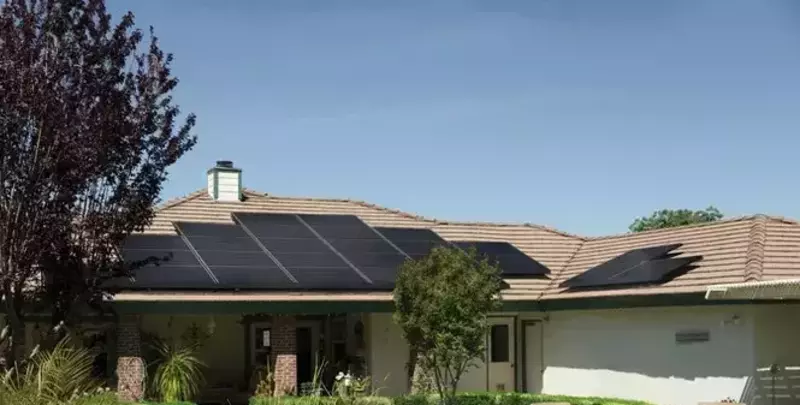
Clean energy generation is a key application of solar energy. It has gained a lot of momentum in recent years. There are two primary technologies to generate electrical power from solar energy:
- Solar Photovoltaic (PV) System
- Concentrating Solar Power (CSP)
Solar Photovoltaic (PV) System
Solar PV panels convert sunlight into electrical energy, generating a direct current (DC). This direct current is then sent to an inverter for conversion from DC to alternating current (AC) which can power your entire house from running your heating, charging your devices to providing power for your appliances.
Read more about how solar panels work?
A drawback of solar PV energy is that it can generate electricity only during the day. To overcome this, homeowners use a battery bank with their rooftop solar PV panels to store electrical power.
Energy engineers and trained technicians can help set up a solar PV system for your house or office using Software to simulate and model solar PV systems which can also estimate the costs of designing a solar PV system.
According to EnergySage, the average installation cost for a 5 kW system in the US is $12,500 to $17,000. Though Government subsidies and rebates can cut your total expenses by 50 percent!
Concentrating Solar Power (CSP)

CSP technology utilizes mirrors to reflect and concentrate sunlight onto a central receiver. This central receiver collects solar energy and converts it to heat. In turn, this heat energy can help in electrical energy generation.
CSP technology is only used on large power plants and is not appropriate for residential use.
#2 Solar-powered Transportation
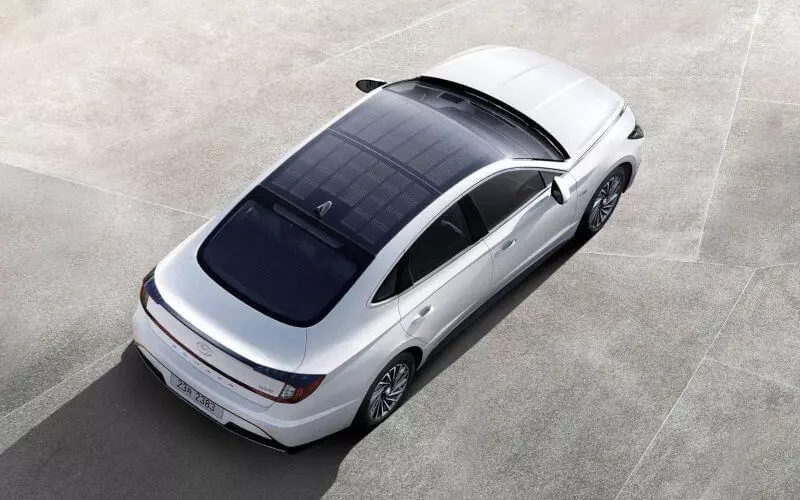
Can solar energy be used for transportation?
Yes! Solar PV-powered transportation is a new trend in the industry.
Recently, Solar Impulse 2 – a solar energy-powered airplane has completed a tour around the world. Flying across the Pacific Ocean and creating a big buzz in iconic images.
Solar-powered buses are now common in densely populated cities of China like Beijing. These buses help China to reduce its carbon footprint as well as provide a mass transit system.
In Australia, companies are trying to make racing cars solely powered by solar energy. Solar energy will revolutionalize the transportation industry in near future.
#3 Solar Water Heater
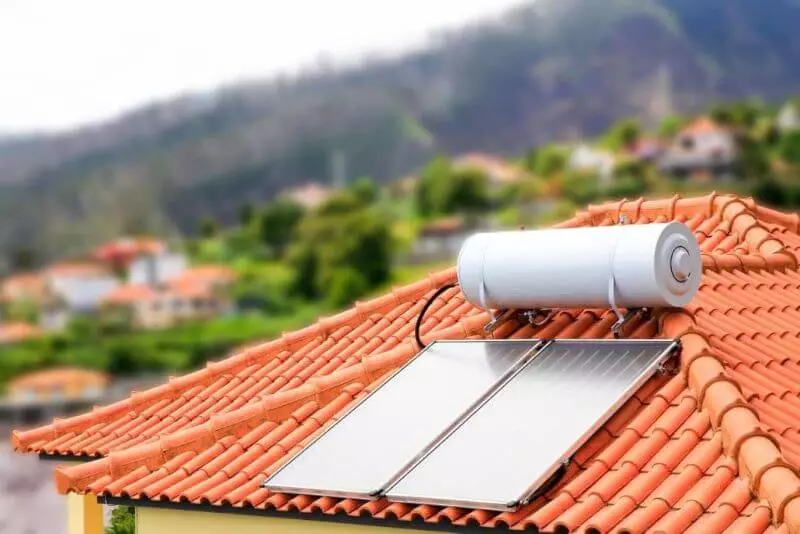
A great way to cut down on your energy use is by using solar energy to heat or warm water.
Solar water heaters use the heat energy from the sun, converting it into thermal energy to heat water. They can replace the traditional expensive gas & electric water heaters in your house.
There are two types of solar water heater systems:
- Active Water Heater Systems
- Passive Water Heater Systems
Active Water Heater Systems
These systems use pumps for circulating water between thermal collectors and storage tanks.
Passive Water Heater Systems
Passive hot water solar system uses a natural circulation method instead of mechanical pumps. Thus they are cheap and less efficient as compared to active water heater systems.
According to the US DOE, these systems have a payback period of 5 to 10 years, with installation costs ranging between $1000 and $4000 USD depending on the system, location and capacity required [Reference: homeadvisor.com].
#4 Solar House Heating
The energy from the sun can be utilized for space heating as well. Solar space heating systems can heat your entire house or office in the winter, on cloudy days, and even at night.
The warmth from either water or air is moved throughout the house. It can be through radiators or tubes used in underfloor heating. Solar space heating requires a large investment. Thus they are commonly used in businesses or commercial applications.
Solar heating technology is a great way to go if you’re serious about using solar energy in your house.
#5 Solar-powered Pumps
Solar-powered pumps are useful in areas where grid electricity is not accessible or practical.
Examples of pumps include solar-powered water pumps to deliver drinking, livestock, and irrigation water. The oil industry has also started to use solar power for pumping systems because of their remote / off-grid locations and increase in environmental awareness.
Active water heater systems can save you a lot of energy. To pump hot water, they still need electricity. So rooftop solar panels can help you power those pumps and save a large amount of electrical energy.
Many applications of solar-powered pumps require a battery bank with a solar PV system for energy storage to let you use electrical energy on demand.
#6 Solar Lighting
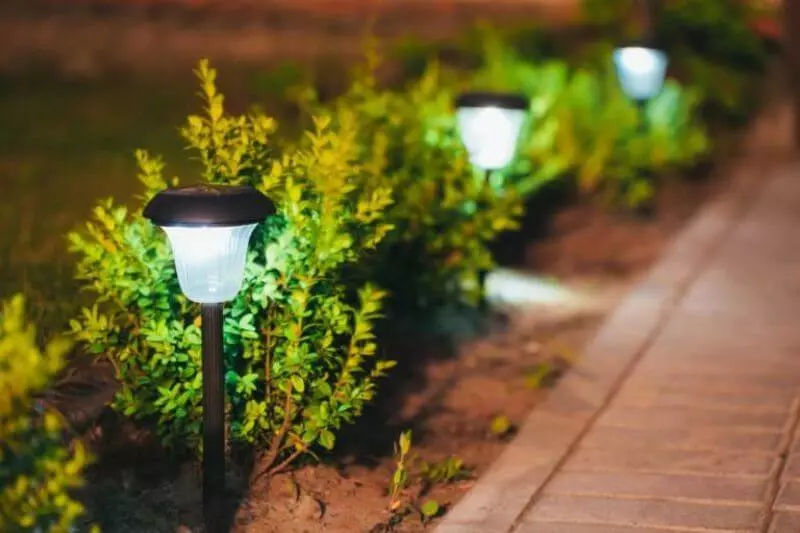
Outdoor lighting can also operate on solar energy. Outdoor solar lighting systems can illuminate your property during the night. Solar LED lights have a small embedded or separate solar PV panel along with battery storage.
They capture energy during the day and consume it during the night for illumination. These solar lights are attractive both for property decor (exterior design) and efficiency.
They cost as low as $20 for a set.
Solar street lighting is another common application of these lights, but only larger, which can provide sufficient light needed for landscapes, walkways, and pathways.
You can also use solar LED indoor lights to illuminate your house.
#7 Solar-powered Cryptocurrency Mining
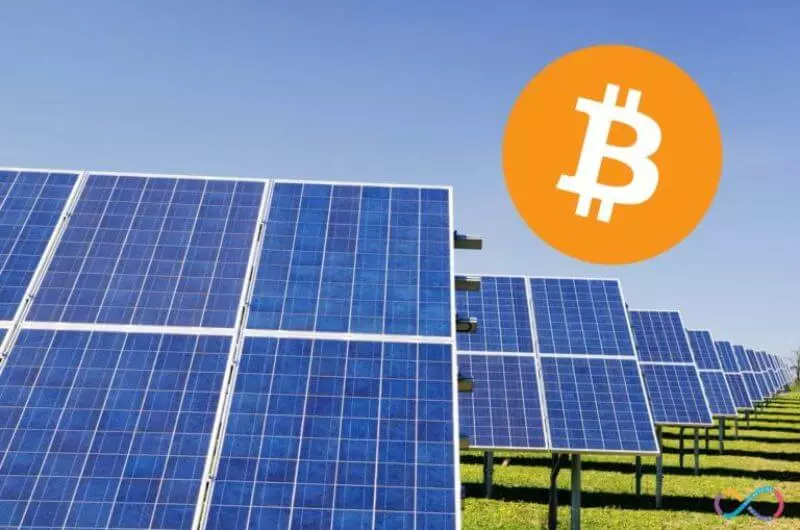
Not exactly for the standard home-office setup! But we’ll add this one to raise awareness about the application of using solar power to mine cryptocurrencies.
Blockchain is the backbone of cryptocurrencies like Bitcoin and Ethereum. Operating a blockchain requires a lot of energy. The cryptocurrency networks continue to expand. As they expand, more power will be needed for mining operations.
Renewable energy can help blockchains fix this problem. Adopting solar energy can help improve the profitability of cryptocurrency investments. As well as make blockchain technology environmentally friendly.
Cryptocurrency mining rigs are composed of 6 to 14 GPUs which can consume $.05 to $0.10 kWh, costing up to $1.4kWh per hour. But, the cost isn’t driven by this factor alone. Cooling is also a major factor in cryptocurrency mining costs too.
The mining rig should have enough cooling. Otherwise, the GPU could burn out faster than expected.
#8 Swimming Pool Solar Heaters
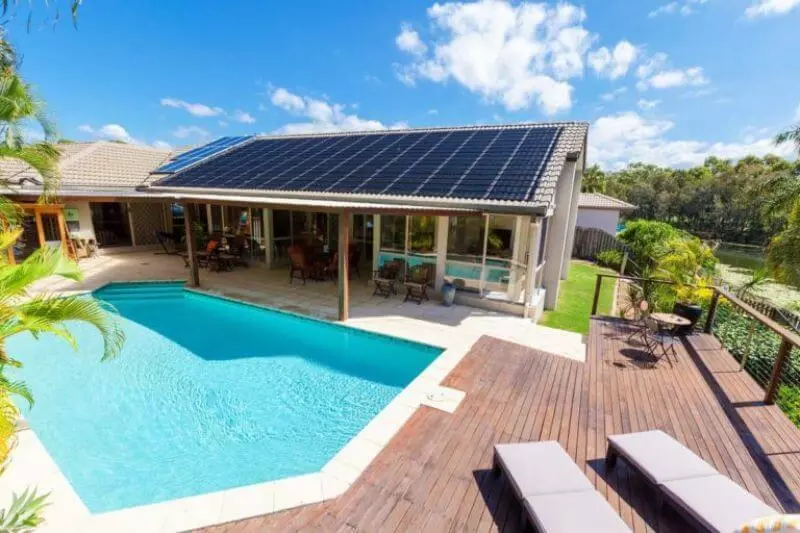
Solar energy can also be used to heat swimming pools.
According to the US Department of Energy:
“solar pool heating is the most cost-effective use of solar energy in many climates.”
The mechanism of swimming pool solar heaters is simple. The water of the pool circulates through a thermal collector. The water is heated by the thermal energy from the sun and then pumped back into the pool. The concept of heating pool water is almost the same as solar water heating systems.
According to US DOE, Swimming pool solar heaters cost around $3000 and $4000 with a payback period of anywhere between 1.5 to 7 years.
Another option for heating the swimming pool using solar energy is using a solar blanket. The floating solar blanket is a passive heating device. It works simply by absorbing the sun’s heat and transmitting it to the water.
#9 Solar Ventilation and Cooling
Solar energy can also be used to power attic ventilation fans or air conditioning systems. They can reduce energy costs associated with heating, ventilation, and air conditioning (HVAC) systems during the summer.
Traditional exhaust fans use a lot of electrical energy. To overcome this, you can buy a self-contained solar roof vent fan. It comes with a small photovoltaic panel attached to the top of the fan.
The solar panel powers the electric DC motor responsible for the fan’s operation. With a built-in solar panel, there is no longer need for a secondary electricity source.
#10 Charging Battery Bank with Solar Panels
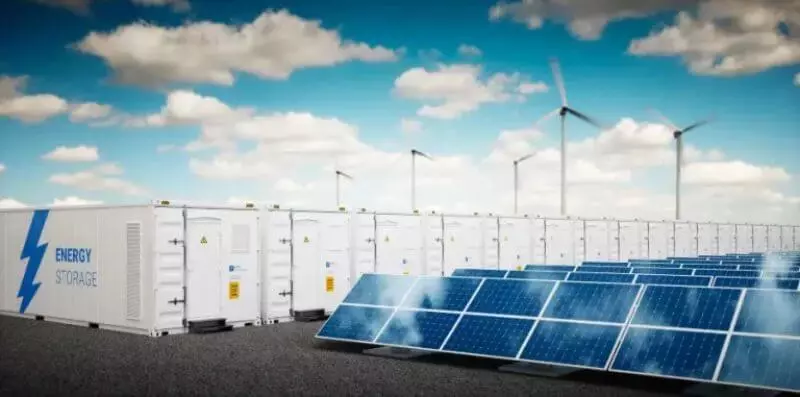
A battery bank is a good way to store electrical energy. Solar PV panels generate direct current. This current can be used to charge a battery or a battery bank using a charge controller. The charge controller ensures that the batteries don’t get overcharged or discharged. Thus helping you keep your battery bank safe.
#11 Solar Energy for Cooking
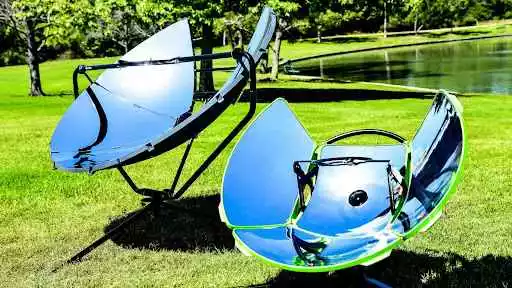
You can also harness the thermal energy of the sun to cook meals. A solar cooker is a great yet simple technology. It utilizes a container lined with foil or another shiny substance.
Different types of solar cookers include panels, reflectors, and box cooking. Solar panel cookers have large reflector areas, while solar box or container ovens are designed to retain the heat. Reflector cookers work by concentrating light onto a smaller area or cooking chamber which can be adjusted through reflection.
#12 Solar Fans for Cooling
Solar energy can also be used for cooling during the summer. Free-standing solar fans use solar energy to operate. These solar fans operate using direct current (DC). These fans can either be connected to a 12V battery or directly to a solar panel.
These fans are very cheap and energy-efficient and have many uses such as cooling a summer house or gazebo to being used in an attic.
Most useful solar powered products that can be used in daily life
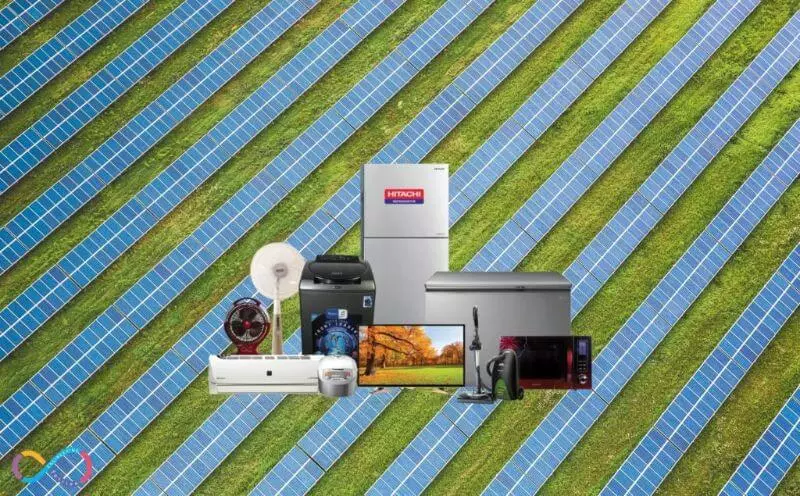
Approximately all gadgets and technologies could use solar power today. If you’re still wondering, that “can solar energy be used to power devices, consumer electronics, and equipment?”. The answer is, yes solar energy can power many of them!
Solar energy can operate electronics ranging from smartphones, wearables to solar dryers, freezers… In this part of the article, we will share some of the most useful products that can be solar powered
#13 Solar Charger Power Bank for Smartphone
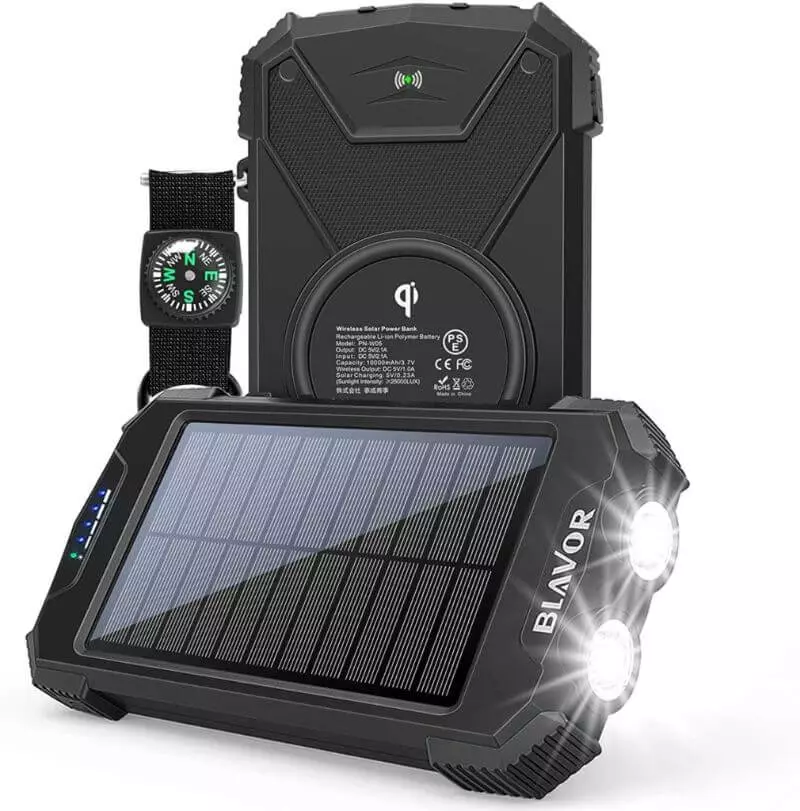
Solar energy can also be used to recharge your smartphone or other small USB-powered devices on the go e.g. portable speakers. The Blavor is one such all-in-one power bank and solar charger. It has a built-in solar panel that recharges the power bank which in turn charges your phone when other sources of power are not available.
Check our in-depth article about solar chargers and power banks: Can a Solar Panel Charge a Power Bank? Choose the right charger.
Moreover, the Blavor solar power bank can be recharged using a USB C type adapter as well. It has a capacity of 10,000 mAh and can recharge your smartphone through Qi wireless technology.
Link: Amazon
#14 Solar-powered Outdoor Music Speakers
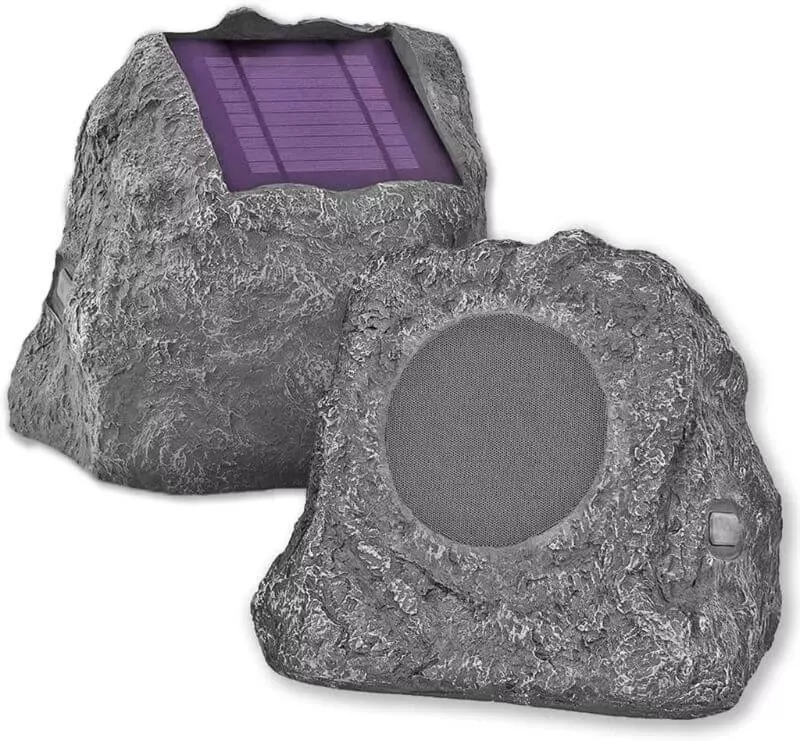
Want to enjoy outdoor music with solar-powered rock-like wireless music speakers?
Victrola is a wireless solar-powered outdoor music speaker. It has a small built-in solar panel with rechargeable batteries. The batteries can last up to 50 hours.
These music speakers have the shape of rocks. The design can help you put the speakers on the ground with ease for solar charging. These speakers are engineered to withstand all weather conditions. Leave them out in rain, snow, or harsh sun – they’ll work just fine each time!
Link: Amazon
#15 Solar Heated Camping Shower Bag
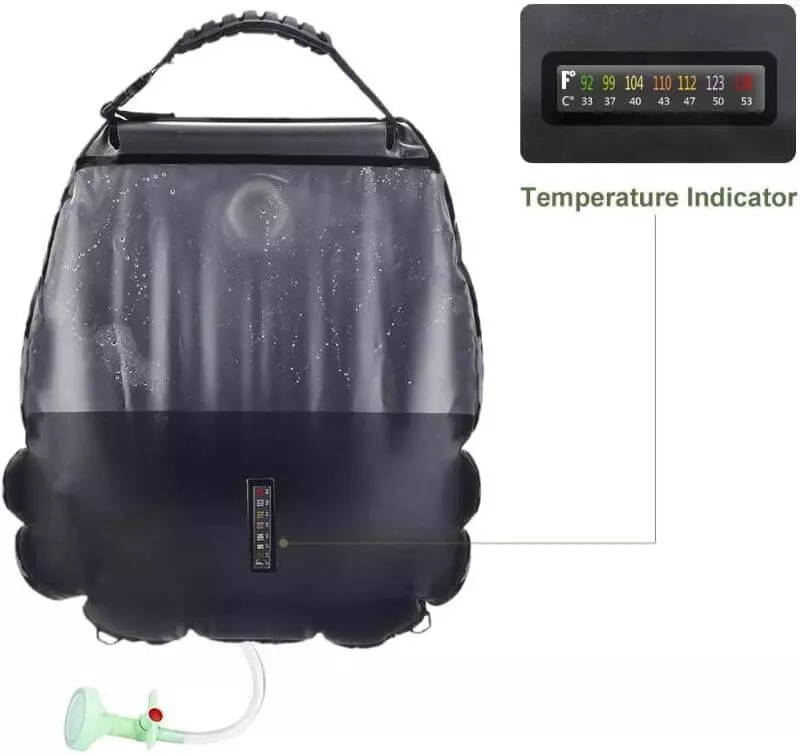
KIPIDA Shower Bag uses the concept of solar heating technology. This bag is perfect for outdoor activities, such as hiking and fishing.
It can hold up to 5 gallons of water at a time so you will get the refreshing shower that you need while outdoors! It heats water to 113°F (45°C) in 3 hours with direct sunlight. The bag also features a temperature indicator.
This product comes with an upgraded hose head. It has adjustable pressure settings, depending on your preferences.
Link: Amazon
#16 Portable Solar Generator (Power Station)
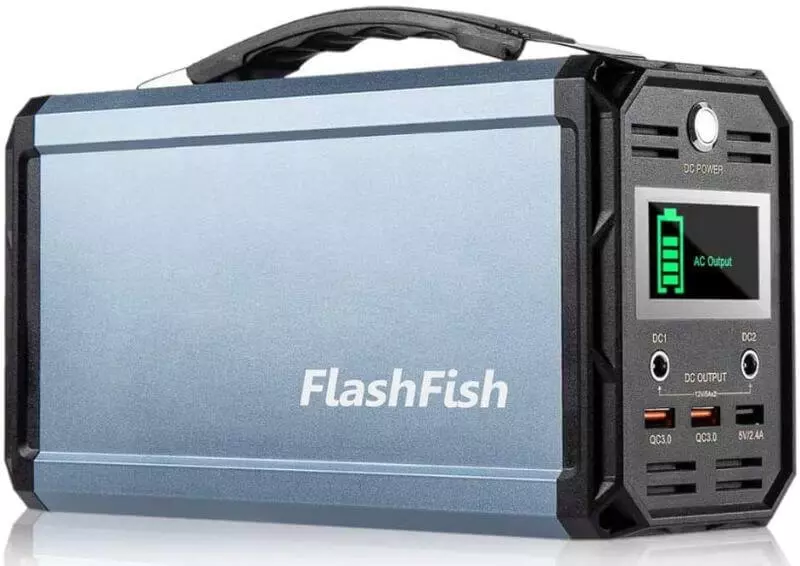
You can also use Solar PV energy to charge a portable power station.
FlashFish is a portable power station that uses solar PV energy. It can supply enough energy to run a cell phone, tablet, laptop, camera, light, drone, CPAP machine, and much more. Its 110V AC outlets can charge your CPAP machine, tablet, laptop, TV, fan, and so on. It also has 2 x 12V DC ports for a car vacuum, car refrigerator, or car air fan.
Moreover, it has 2 x 3.0 USB and 1 x 2.4A USB ports that can charge your phones, drones, iPad, GPS, mp3, camera, and many more.
Its battery pack can be recharged from the sun using a solar panel. It can also be fully charged by being plugged into the wall outlet or by plugging into your car’s 12V socket.
Link: Amazon
#17 Portable Solar Refrigerator

Solar panels (12V or 24V) can also be used to power refrigerators. These refrigerators are available in both portable and non-portable types.
Kalamera is a portable solar refrigerator that can operate on a 12V outlet. The temperature of the solar refrigerator can range from -4℉ to 50℉.
This eco-friendly camper refrigerator features a digital thermostat for easy temperature control. It also has a battery protection system that keeps the battery charged for longer.
Link: Amazon
Summary:
Thanks to advancements in solar technology, an increasing number of products are coming out at a more affordable price every day. So now we can all help reduce our carbon footprint by using these products that harness energy from the sun.
If you have other examples of products, devices, that use solar energy we’d love to hear about them. Just drop a note in the comments!
References:
[1] The first recorded evidence of solar energy usage is dating back to 700 B.C
[2] The global market for solar energy was valued at $52.5 billion in 2018 and is projected to grow exponentially by 2026 to $223 billion according to a market report from Allied Market Research.




![Types of Engineers and What they Do [Explained]](https://www.engineeringpassion.com/wp-content/uploads/2022/04/types-of-engineers-and-what-they-do-280x210.jpg)




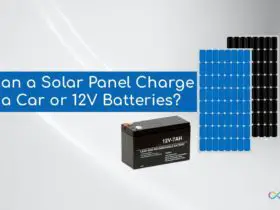
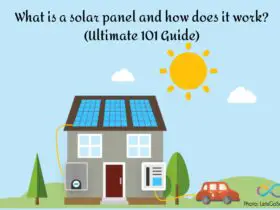

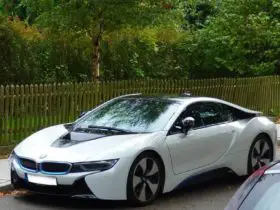
Leave a Reply